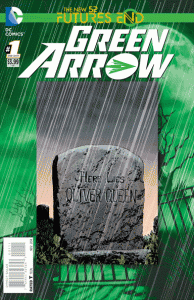 So, the big news this week is that DC, who had so much success with their 3D cover promotion last September, is doing it again this year, with a few twists. First, the covers are lenticular instead of 3D; that means, while they appear to have depth like the 3D covers, they actually have two scenes embedded in them, and if you tilt the cover back and forth you can toggle between them — so, for example, on the Green Arrow cover, one scene just shows Oliver Queen’s tombstone, but when you look from another angle his ghostly image appears too, superimposed on it; on the Detective cover, one scene shows Batman posing on a rooftop; the other adds in The Riddler as his sidekick. NOTE: click on each cover, and, if I’ve embedded them right, you should be able to see them in all their lenticular, dual-image glory. Pretty cool, eh?
So, the big news this week is that DC, who had so much success with their 3D cover promotion last September, is doing it again this year, with a few twists. First, the covers are lenticular instead of 3D; that means, while they appear to have depth like the 3D covers, they actually have two scenes embedded in them, and if you tilt the cover back and forth you can toggle between them — so, for example, on the Green Arrow cover, one scene just shows Oliver Queen’s tombstone, but when you look from another angle his ghostly image appears too, superimposed on it; on the Detective cover, one scene shows Batman posing on a rooftop; the other adds in The Riddler as his sidekick. NOTE: click on each cover, and, if I’ve embedded them right, you should be able to see them in all their lenticular, dual-image glory. Pretty cool, eh?
The other change is that, unlike last year’s villain-origin 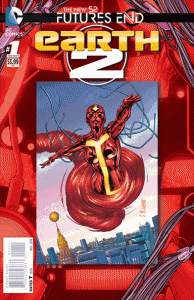 theme and 23.1, 23.2, etc. numbering, these books are all one-shot #1s of the regular titles — but set five years in the future, in the same “time” as DC’s weekly comic Futures End; in effect, they’re extra stories about that book’s timeline, meant to fill in blanks and let us know what the various heroes have been doing for the last five years (in that timeline, Earth-2 has been destroyed/invaded by Darkseid, and so millions of refugees from it have streamed over to Earth-1; since most Earth-2 residents are dopplegangers of Earth-1 people, that’s creeped out most of Earth-1’s population, and so the refugees face discrimination, containment camps, etc. Added to this (pay attention; there might be a quiz later), the Batman Beyond character from another 30 years in the future has traveled
theme and 23.1, 23.2, etc. numbering, these books are all one-shot #1s of the regular titles — but set five years in the future, in the same “time” as DC’s weekly comic Futures End; in effect, they’re extra stories about that book’s timeline, meant to fill in blanks and let us know what the various heroes have been doing for the last five years (in that timeline, Earth-2 has been destroyed/invaded by Darkseid, and so millions of refugees from it have streamed over to Earth-1; since most Earth-2 residents are dopplegangers of Earth-1 people, that’s creeped out most of Earth-1’s population, and so the refugees face discrimination, containment camps, etc. Added to this (pay attention; there might be a quiz later), the Batman Beyond character from another 30 years in the future has traveled 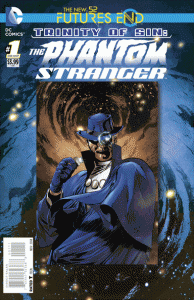 back in time to DC +5, because in his time Brother Eye has taken over most of the planet, turned the heroes into cyborg insects, and generally behaved badly, and he wants to stop that from happening).
back in time to DC +5, because in his time Brother Eye has taken over most of the planet, turned the heroes into cyborg insects, and generally behaved badly, and he wants to stop that from happening).
Like the 3D covers, these will look awesome all lined up on your wall, which may be reason enough to get a complete set: but are the insides any good? I found them as a group less boring than last year’s villain books, many of which had a numbing sameness to their plots, so that at least gave these new efforts a head start. Otherwise…:
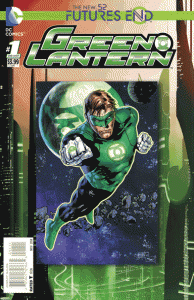 Green Arrow #1 — Writer: Jeff Lemire; Art: Andrea Sorrentino
Green Arrow #1 — Writer: Jeff Lemire; Art: Andrea Sorrentino
Earth 2 #1 — Writer: Daniel H. Wilson; Pencils: Eddy Barrows; Inks: Eber Ferreira
These were the two best, because both are tied in closely with Futures End. In a welcome case of editorial competence, Green Arrow takes off directly from last week’s Futures End revelation about that character’s fate (we’d previously seen him “die” in the first issue of that title), elaborates on it, sets up some future plot  developments and actually makes sense while doing it. . Earth 2 focuses on Michael Holt/Mr. Terrific (whose inventions are going to lead to the Brother Eye problem that the Batman Beyond guy is trying to solve), and his battle with a couple of dimensional variations of main antagonist Terry Sloane, while answering a couple of questions about that character and then adding some new ones. Since the Brother Eye thing is the main plot driver for the weekly book, developments here are sure to be significant over there, too.
developments and actually makes sense while doing it. . Earth 2 focuses on Michael Holt/Mr. Terrific (whose inventions are going to lead to the Brother Eye problem that the Batman Beyond guy is trying to solve), and his battle with a couple of dimensional variations of main antagonist Terry Sloane, while answering a couple of questions about that character and then adding some new ones. Since the Brother Eye thing is the main plot driver for the weekly book, developments here are sure to be significant over there, too.
Phantom Stranger #1 — Plot: Dan Didio; Script: J. M. DeMatteis; Art: Phil Winslade
Since the Stranger’s book has been cancelled (he’s going to become one part of a new title, Trinity of Sin), this is actually a coda to that comic: while still set five years in the 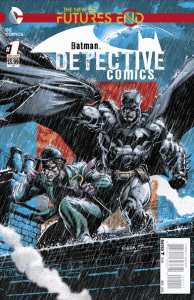 future, it resolves a number of elements of the Stranger’s origin and circumstances, in a way that looks like it’ll stick; that makes it a rare example of one of these stories that will definitely stay in continuity (the others will only be “true” if the DC +5 timeline holds, but the “Futures End” title by itself makes that unlikely). As such, any present or past fan of the character will probably want this issue.
future, it resolves a number of elements of the Stranger’s origin and circumstances, in a way that looks like it’ll stick; that makes it a rare example of one of these stories that will definitely stay in continuity (the others will only be “true” if the DC +5 timeline holds, but the “Futures End” title by itself makes that unlikely). As such, any present or past fan of the character will probably want this issue.
Green Lantern #1 — Writer: Robert Venditti; Art: Martin Coccolo and Aaron Lopresti
Action #1 — Writer: Sholly Fisch; Art: Pascal Alixe and Vicente Sifuentes
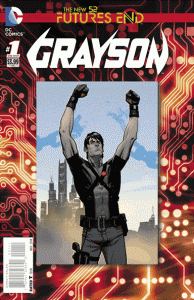 These answer the question “Where are Hal Jordan and Superman while all the Futures End stuff is unfolding?”, although the real answer is “If you take a few of the big guns off the table, you get a more interesting, harder-to-resolve plot.” Turns out Jordan’s in space fighting some leftovers from Blackest Night and Final Crisis; Venditti does a decent job of integrating those elements into a coherent, affecting story, all in just 20 pages. Readers of Futures End already know where Clark Kent is (that was another reveal just a week ago), and Action doesn’t add much to that information, instead using a Superman stand-in (who looks a lot like that sand Supes from the early-’70s Denny O’Neil era) to dole out his various powers to some otherwise-
These answer the question “Where are Hal Jordan and Superman while all the Futures End stuff is unfolding?”, although the real answer is “If you take a few of the big guns off the table, you get a more interesting, harder-to-resolve plot.” Turns out Jordan’s in space fighting some leftovers from Blackest Night and Final Crisis; Venditti does a decent job of integrating those elements into a coherent, affecting story, all in just 20 pages. Readers of Futures End already know where Clark Kent is (that was another reveal just a week ago), and Action doesn’t add much to that information, instead using a Superman stand-in (who looks a lot like that sand Supes from the early-’70s Denny O’Neil era) to dole out his various powers to some otherwise-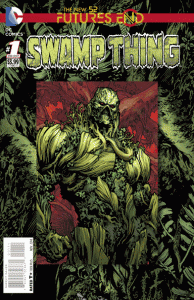 ordinary people as some kind of sociology experiment that leads to the book’s “planting seed” theme. OK, although other than that one small revelation this is probably the comic that least moves its main character, or the Futures End story, along.
ordinary people as some kind of sociology experiment that leads to the book’s “planting seed” theme. OK, although other than that one small revelation this is probably the comic that least moves its main character, or the Futures End story, along.
Detective Comics #1 — Writer: Brian Buccellato; Art: Scott Hepburn, Cliff Richards and Fabrizio Fiorentino
Grayson #1 — Plot: Tom King and Tim Seeley; Writer: Tom King; Art: Stephen Mooney
Swamp Thing #1 — Writer: Charles Soule; Art: Jesus Saiz
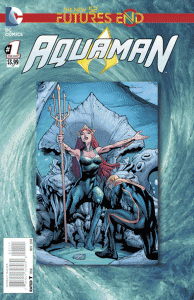 Aquaman #1 — Writer: Dan Jurgens; Pencils: Alvaro MartinezInks: Raul Fernandez
Aquaman #1 — Writer: Dan Jurgens; Pencils: Alvaro MartinezInks: Raul Fernandez
Batwing #1 — Writers: Jimmy Palmiotti and Justin Gray; Pencils: Eduardo Pansica; Inks: Julio Ferreira and JP Mayer
These remaining books all use their “five-year jump” one-shot much the way the Marvel “100th Anniversary” books have done — as the climax of a supposedly-longer storyline that would have been published during the intervening years. That’s a tall order with only 20 pages to work with, but they’re generally up to the task; Detective has Batman and The Riddler team up to stop Calendar Man, who’s  taken hostages on “Arkham Island”: the interplay between the two foes, especially in its callbacks to the recent “Zero Year” story, and its generally fast pace make it work, although the ending falls off a trifle. Grayson uses an unusual cascading-flashback method to tell its story in reverse; it’s not a new conceit, but it’s cleverly done, especially the way the last page echoes the first, suggesting the story’s resolution without actually saying it. Swamp Thing sends its hero on a quest and final battle, and is the best at cramming the entire +5 years of plot into its space, while Aquaman only tells the first half of its tale (with Aquaman and the Others, later in the month, set to complete it), and Batwing matches Phantom Stranger in giving its hero the most complete resolution, and still leaving him in a good position for future stories.
taken hostages on “Arkham Island”: the interplay between the two foes, especially in its callbacks to the recent “Zero Year” story, and its generally fast pace make it work, although the ending falls off a trifle. Grayson uses an unusual cascading-flashback method to tell its story in reverse; it’s not a new conceit, but it’s cleverly done, especially the way the last page echoes the first, suggesting the story’s resolution without actually saying it. Swamp Thing sends its hero on a quest and final battle, and is the best at cramming the entire +5 years of plot into its space, while Aquaman only tells the first half of its tale (with Aquaman and the Others, later in the month, set to complete it), and Batwing matches Phantom Stranger in giving its hero the most complete resolution, and still leaving him in a good position for future stories.
Whew! Not much space for other books this week after all that, but there were a number of first issues that debuted too, and they don’t deserve to get lost in all the lenticular-cover hype, so let’s look:
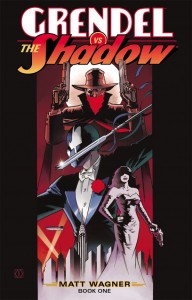 Grendel vs. The Shadow #1 — Creator: Matt Wagner
Grendel vs. The Shadow #1 — Creator: Matt Wagner
Wagner’s great; he has an urbane, smooth style combined with a gritty pulp sensibility (in both his writing and his art), which works particularly well with characters like The Shadow. Grendel, his own creation from the ’80s, is a villain who, in his Hunter Rose identity, moves in much the same upper-class circles as Lamont Cranston, so mix in a little supernatural time travel to get both characters in the 1930s, and we’re off. Wagner does a lot more writing than drawing any more, but he’s had almost 30 years to hone his visual chops, and they’re very well-suited to this darkly-sophisticated material; getting to see him in action again makes this the book of the week.
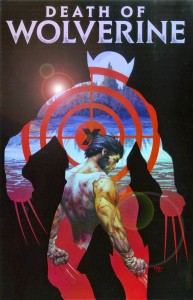 Death of Wolverine #1 (of 4) — Writer: Charles Soule; Pencils: Steve McNiven; Inks: Jay Leisten
Death of Wolverine #1 (of 4) — Writer: Charles Soule; Pencils: Steve McNiven; Inks: Jay Leisten
I wasn’t predisposed to like this book (especially considering Marvel pulled that bait-and-switch with the regular Wolverine comic where it looked like they were going to kill him there, and then after a multiple-issue storyline were like, hey, fooled you, he’s still alive; now come over to this more-expensive book and spend $20 over four issues to watch us kill him here instead), but Soule/McNiven is an effective creative team — the book looks good, and while it’s $4.99 it’s got 23 pages of story and almost 20 pages of editorial material, including sketches, an interview with Wolverine creator Len Wein, and a “director’s cut” look at the first 11 pages of the script, coupled with McNiven’s pencils based on it. For process junkies, it’s all fascinating, and while my adult self is aware of the self-indulgent and cynical nature of the whole thing, my 12-year-old self appreciates that at least it’s high-quality self-indulgent cynicism, and is happy to get swept up in it.
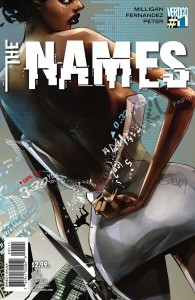 The Names #1 ( of 8 ) — Writer: Peter Milligan; Art: Leandro Fernandez
The Names #1 ( of 8 ) — Writer: Peter Milligan; Art: Leandro Fernandez
A Wall Street trader leaps to his death, an apparent suicide, but his wife suspects otherwise; she has to team up with his son from a previous marriage, an early-teen math prodigy, to battle the shadowy cabal that actually killed him. This is decent Milligan, with a good balance between the psychological stuff and the action, and a very strong protagonist in the wife; she’s a fighter, and Fernandez makes her both strong and attractive, while slightly exaggerating the bad guys (especially the psycho killer who handles their dirty work) to make them scary and formidable.
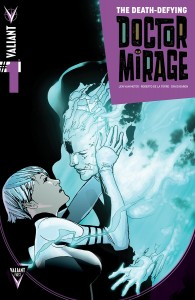 Doctor Mirage #1 — Writer: Jen van Meter; Art: Roberto de la Torre
Doctor Mirage #1 — Writer: Jen van Meter; Art: Roberto de la Torre
This is another Valiant relaunch, although it shares little more than a name with the previous series: the doctor of the title is a woman, Shan Fong, who can see and talk to dead people. She’s in a bad place when the first issue begins: her husband has died recently; they were some sort of supernatural adventurers (he went by “Doctor Mirage” too), and something went horribly wrong, and now she can’t “find” his spirit, leaving her shattered. Her agent has to urge her to be a reluctant medium to people who’ll pay to communicate with their deceased loved ones. Then, a wealthy and mysterious client hires her, and that leads to a clue about where her husband might be…. de la Torre has a loose, sketchy art style that works well with the material, while the story is smartly plotted and makes Shan an appealing, sympathetic and accomplished protagonist; as with The Names, after reading the first issue I wanted to spend more time with this main character, and see what she’d do next.
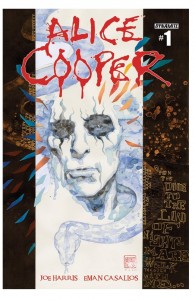 Alice Cooper #1 — Writer: Joe Harris; Art: Eman Casallos
Alice Cooper #1 — Writer: Joe Harris; Art: Eman Casallos
This one’s worth mentioning because it’s always nice to see Phoenix’s own Vincent Furnier maintaining a pop-culture presence. The story has Alice as a lord of nightmares, who’s been held captive for a long time, then escapes and has to fight to defend his realm; if that sounds a lot like The Sandman… well, both the script and the art are trying very hard to imitate that book (Gaiman’s had his own crack at writing an Alice comic in the past, so there’s kind of a cosmic turnabout-is-fair-play thing going on there). While they aren’t entirely successful, those are very big shoes to fill, and there’s at least enough here to set up an entertaining, if derivative, story (there’s also a bit about a young bullied boy who’s able to summon Alice, which was sort of the plot of Marvel’s Sandman book; I’d be impressed if that was some sort of subtle in-joke). This is worth buying just so if you run into the guy on one of our Valley golf courses (or at his restaurant downtown), you can get him to autograph it.
 Ex-Con #1 — Writer: Duane Swierczynski; Art: Keith Burns
Ex-Con #1 — Writer: Duane Swierczynski; Art: Keith Burns
This is an LA noir story with a gimmick: the title character has synesthesia, where he sees people’s personalities as colors: he’s able to subconsciously “read” someone’s aura to tell if they’re jealous, angry, lying, etc. Employing this useful skill to become a con artist, he does well until he eventually rips off the wrong powerful person, gets betrayed and ends up doing five years in prison — and, when he gets out, his talent doesn’t work any more, but he’s reluctantly pulled back into the grifter life anyway — which is where the first issue ends, and the story really begins. This suffers from a misfortune in timing, since Brubaker and Phillips’s The Fade Out, an LA noir which came out just last week, was a hard act to follow, but it’s still an above-average crime comic.
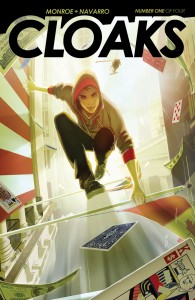 Cloaks #1 (of 4) — Writer: Caleb Monroe; Art: Mariano Navarro
Cloaks #1 (of 4) — Writer: Caleb Monroe; Art: Mariano Navarro
This is a book about a kid who can do magic — but “real” magic, which is to say the art of illusion. He’s been apprenticed to a master magician who died, and now works street magic as a con game, sometimes branching out to higher-level marks. Then, he gets caught; presumably (and according to the “next issue” box), he’ll end up using his talents for some sort of government spy agency. This is another “OK” comic — the art reminds me of Brian Hurtt (particularly his work on the Steve Gerber Hard Time; the kid here sometimes looks quite a bit like that one), and the script shows some nice research into the magician’s art. Like a lot of OK comics today, it reads like a pilot to a cable TV series, the kind you might come across while channel surfing and that has just enough little hooks, twists and character bits to get you to keep watching.



